Eichhornia Kunth.
water hyacinth, anchored water hyacinth
Pontederiaceae
tropical America, Africa
Eichhornia azurea (Sw.) Kunth
E. crassipes (Mart.) Solms
E. diversifolia (Vahl) Urb.
E. heterosperma AlexanderE. natans (P. Beauvois) Solms
E. paniculata (Spreng.) Solms
U.S. Federal Noxious Weed: Eichhornia azurea
Identification: Eichhornia azurea can be distinguished from other Eichhornia by its elongate, fan-like submersedsubmersed:
see submergedleaves and elongate, anchored floating stem with large obovateobovate:
(adj) ovate, with the narrow end at the base, erect leaves with slender petioles.
Eichhornia crassipes is introduced into numerous tropical and subtropical countries around the world. Eichhornia paniculata, E. diversifolia and E. azurea have historical records in Texas and Florida, but apparently no extant populations have been substantiated recently in the United States.
Eichhornia azurea (Sw.) Kunth is a major aquatic weed in some countries and an aquatic weed on the U.S. federal noxious weed list.
E. crassipes (Mart.) Solms is considered one of the world's most serious aquatic weeds and is declared an aquatic noxious weed in many countries.
Due to the weed status of E. crassipes and E. azurea, several, and in some cases, all species of Eichhornia have been subsequently designated as prohibited imports in various countries.
submersedsubmersed:
see submerged
 , emergentemergent:
, emergentemergent:
(adj) (syn. emersed) with parts raised out of the water; extending up out of the water
 , anchored floating stem, or free floating stoloniferous rosetterosette:
, anchored floating stem, or free floating stoloniferous rosetterosette:
(n) a radiating cluster of leaves, usually close to the ground at the base of a plant
 plant
plant
Annual or perennialperennial:
(adj) (of a plant) having a life cycle of more than two years
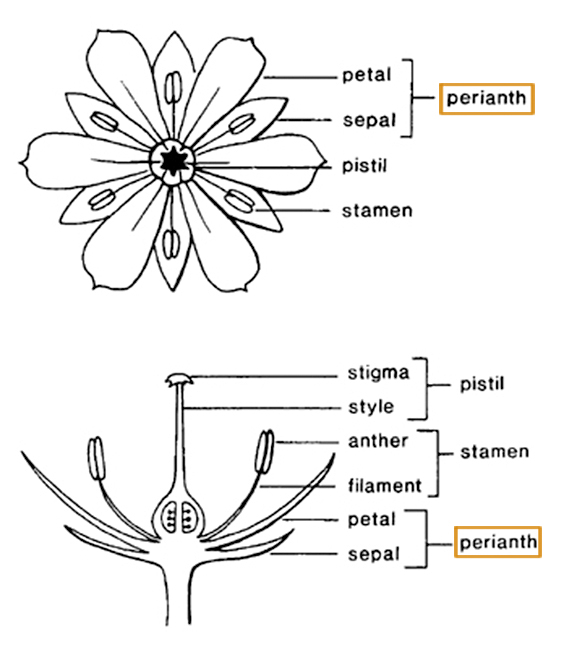 . Stems floating, stoloniferous, or creeping, compact and rhizomatousrhizomatous:
. Stems floating, stoloniferous, or creeping, compact and rhizomatousrhizomatous:
(adj) possessing rhizomes
 or elongate. Leaves submergedsubmerged:
or elongate. Leaves submergedsubmerged:
(adj) (syn. submersed) under water; submerged below the water surface
 , floating, or emergentemergent:
, floating, or emergentemergent:
(adj) (syn. emersed) with parts raised out of the water; extending up out of the water
 (or a combination of any two), in basalbasal:
(or a combination of any two), in basalbasal:
(adj) at or pertaining to the base, or point of attachment
 rosetterosette:
rosetterosette:
(n) a radiating cluster of leaves, usually close to the ground at the base of a plant
 or caulinecauline:
or caulinecauline:
(adj) pertaining to or belonging to the stem
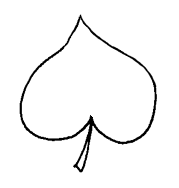 , alternatealternate:
, alternatealternate:
(adj) (of leaves) bearing one leaf per node; placed singly on the stem at different heights
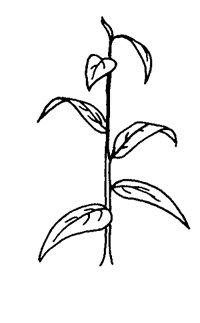 , distichousdistichous:
, distichousdistichous:
(adj) (of leaves or flowers) distinctly arranged in two ranks along an axis; leaves may be opposite or alternate
 (2 rows), or spirally arranged, sessilesessile:
(2 rows), or spirally arranged, sessilesessile:
(adj) attached directly, without a stalk
 or petiolatepetiolate:
or petiolatepetiolate:
(adj) relating to or in the form of a petiole; bearing petioles
 , petiolepetiole:
, petiolepetiole:
(n) the stalk of a leaf
 often inflatedinflated:
often inflatedinflated:
(adj) bladdery; swollen, or appearing so
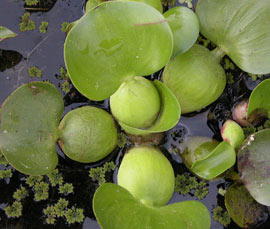 with aerenchymaaerenchyma:
with aerenchymaaerenchyma:
(n) plant tissue with large, gas-filled intercellular spaces that facilitates gaseous exchange and maintains buoyancy
 in floating plants; submersedsubmersed:
in floating plants; submersedsubmersed:
see submerged
 leaves linear, emersedemersed:
leaves linear, emersedemersed:
see emergent
 leaves ovateovate:
leaves ovateovate:
(adj) egg-shaped in outline; generally with the broad end at or near the base
 to orbicularorbicular:
to orbicularorbicular:
(adj) circular in outline
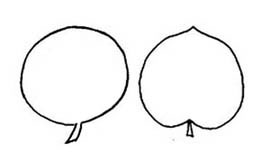 , venationvenation:
, venationvenation:
(n) the arrangement of veins in a leaf
 inconspicuous, parallel to palmatepalmate:
inconspicuous, parallel to palmatepalmate:
(adj) (of leaves or venation) with lobes, leaflets, divisions or veins originating from the same point
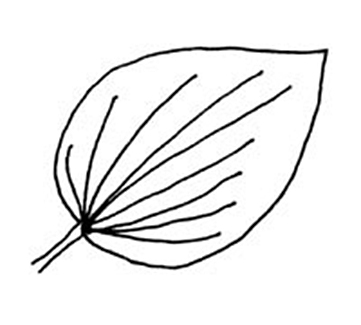 ; base rounded to cordatecordate:
; base rounded to cordatecordate:
(adj) heart-shaped; in the form of two rounded lobes
 ; marginmargin:
; marginmargin:
(n) edge; rim
 entire. Inflorescenceinflorescence:
entire. Inflorescenceinflorescence:
(n) the arrangement of flowers on the floral axis
 a spikespike:
a spikespike:
(n) an indeterminate, unbranching inflorescence of sessile flowers or flower clusters on a usually elongated axis
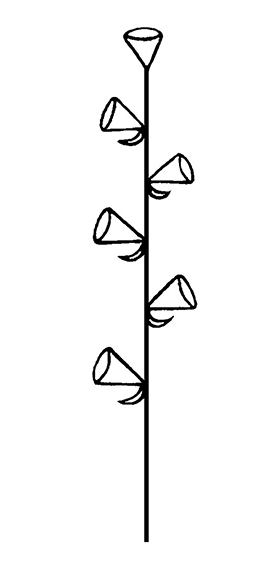 or paniclepanicle:
or paniclepanicle:
(n) an indeterminate, branched (often much-branched) inflorescence; the ultimate units may be of a different inflorescence type
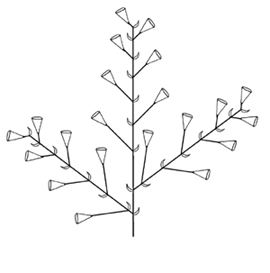 , subtended by 2 reduced, dissimilar leaves (spathes); lower spathespathe:
, subtended by 2 reduced, dissimilar leaves (spathes); lower spathespathe:
(n) a large bract or bracts subtending and often enclosing an inflorescence
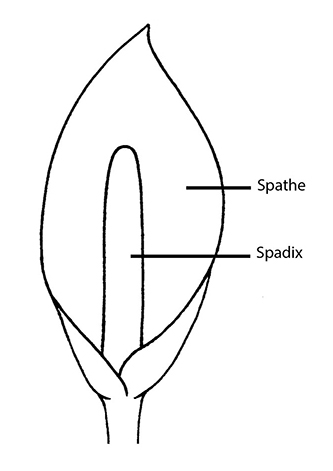 leaf-like, upper scalescale:
leaf-like, upper scalescale:
(n) any thin, usually small and dry, membranous to leathery bract
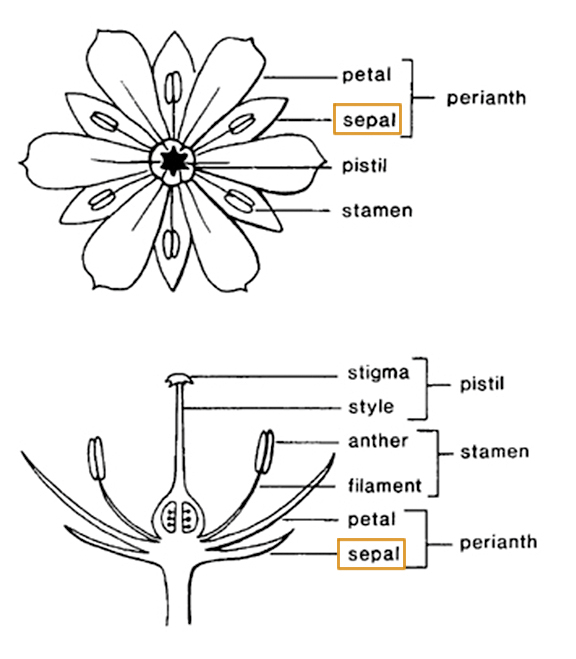 -like. Flower zygomorphiczygomorphic:
-like. Flower zygomorphiczygomorphic:
(adj) bilaterally symmetrical; symmetrical along only one plane
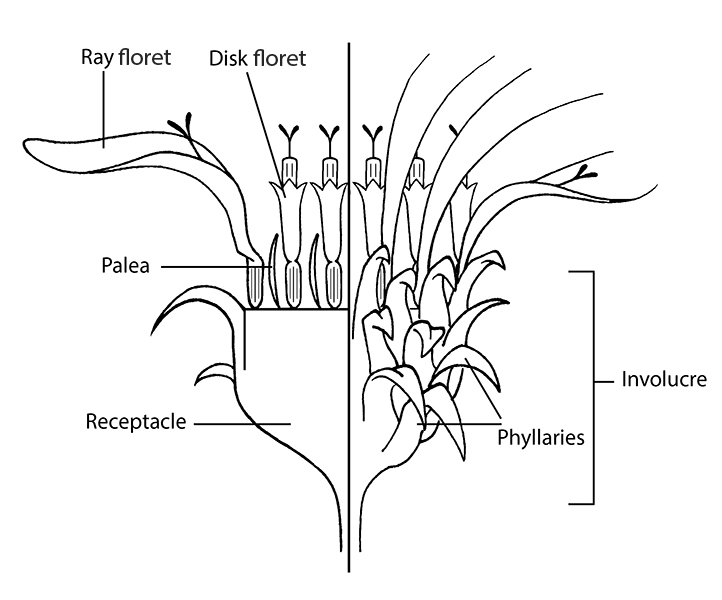 ; perianthperianth:
; perianthperianth:
(n) collective term for the calyx and corolla of a flower; also used for floral whorl(s) in which the calyx and corolla cannot be resolved; any of the leaves or bracts surrounding the sex organs of bryophytes
 fused, of 6 showy tepals in 2 whorls of 3; lobes unequal, adaxialadaxial:
fused, of 6 showy tepals in 2 whorls of 3; lobes unequal, adaxialadaxial:
(adj) pertaining to the side facing toward the axis, as in the upper surface of a leaf
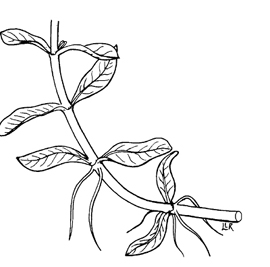 lobe larger than rest; tepals usually pink to purple with yellow spot on adaxialadaxial:
lobe larger than rest; tepals usually pink to purple with yellow spot on adaxialadaxial:
(adj) pertaining to the side facing toward the axis, as in the upper surface of a leaf
 lobe. Dispersal by numerous seeds or stem fragments; seeds of E. crassipes may be viable in the sediment for 15 years.
lobe. Dispersal by numerous seeds or stem fragments; seeds of E. crassipes may be viable in the sediment for 15 years.
all types of slow flowing or still water bodies
Eichhornia contains six species, of which five are presently cultivated for aquaria or ponds, and one, E. paniculata, is often a research subject in flower structure genetics.